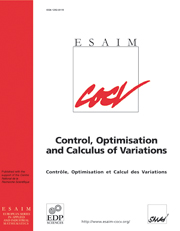Article contents
Une approche géométrique du contrôle optimal de l'arcatmosphérique de la navette spatiale
Published online by Cambridge University Press: 15 September 2002
Abstract
The aim of this article is to make some geometric remarks and some preliminary calculations in order to construct the optimal atmospheric arc of a spatial shuttle (problem of reentry on Earth or Mars Sample Return project). The system describing the trajectories is in dimension 6, the control is the bank angle and the cost is the total thermal flux. Moreover there are state constraints (thermal flux, normal acceleration and dynamic pressure). Our study is mainly geometric and is founded on the evaluation of the accessibility set taking into account the state constraints. We make an analysis of the extremals of the Minimum Principle in the non-constrained case, and give a version of the Minimum Principle adapted to deal with the state constraints.
Keywords
- Type
- Research Article
- Information
- Copyright
- © EDP Sciences, SMAI, 2002
References
- 9
- Cited by




